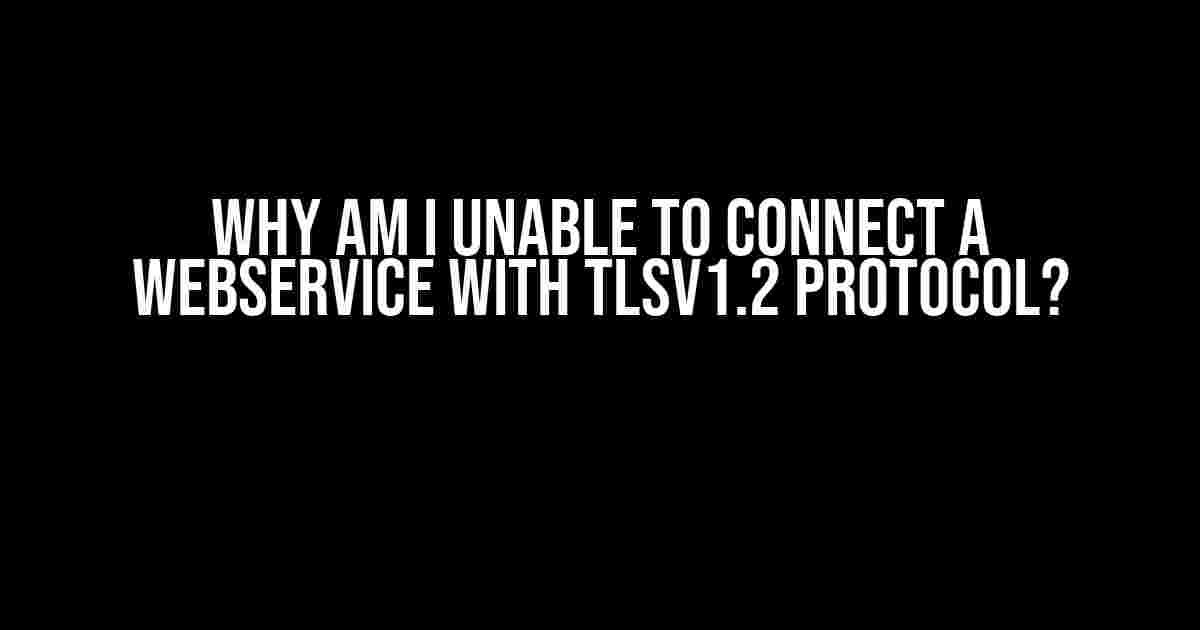Imagine you’re trying to connect to a web service, and suddenly, you’re faced with an error message that says ” unable to connect”. Frustrating, right? You’re not alone! Many developers have struggled with this issue, and it’s often due to the TLSv1.2 protocol. But don’t worry, we’re here to help you troubleshoot and fix the problem.
What is TLSv1.2 protocol?
TLSv1.2 (Transport Layer Security version 1.2) is a cryptographic protocol used to provide secure communication between a client and a server. It’s the successor of SSL (Secure Sockets Layer) and is widely used for secure online transactions. TLSv1.2 is considered more secure than its predecessors, but it can also be more restrictive, which might cause connection issues.
Common reasons for connection failure
Before we dive into the solutions, let’s identify the common reasons why you might be unable to connect to a web service using TLSv1.2:
- Outdated or incompatible SSL/TLS implementation: If your client or server is using an outdated or incompatible SSL/TLS implementation, it might not support TLSv1.2.
- Misconfigured server or client: Improperly configured servers or clients can prevent a successful connection.
- Certificate issues: Problems with the SSL/TLS certificate, such as an untrusted certificate authority or expired certificates, can cause connection failures.
- FIREWALL or PROXY restrictions: Firewalls or proxies might block the connection or restrict the protocol version.
- Programming language or library limitations: Some programming languages or libraries might not support TLSv1.2 or have limitations that prevent a successful connection.
Troubleshooting steps
Now that we’ve identified the common reasons, let’s go through the troubleshooting steps to help you resolve the issue:
Step 1: Check your SSL/TLS implementation
Verify that your client or server is using a compatible SSL/TLS implementation that supports TLSv1.2. You can check the documentation or contact the vendor to ensure compatibility.
Step 2: Verify server configuration
Check the server configuration to ensure that TLSv1.2 is enabled and correctly configured. You can use tools like OpenSSL to test the server’s SSL/TLS configuration:
openssl s_client -connect:443 -tls1_2
This command will test the connection using TLSv1.2. If you receive an error, it might indicate a misconfiguration or incompatibility issue.
Step 3: Check certificate issues
Verify the SSL/TLS certificate to ensure it’s valid, trusted, and hasn’t expired. You can use tools like OpenSSL to check the certificate:
openssl s_client -connect:443 -showcerts
This command will display the certificate details. Check for any errors or warnings related to the certificate.
Step 4: Check FIREWALL or PROXY restrictions
Verify that your firewall or proxy isn’t blocking the connection or restricting the protocol version. Check the firewall logs and configuration to ensure that TLSv1.2 is allowed.
Step 5: Check programming language or library limitations
If you’re using a specific programming language or library, check its documentation to ensure that it supports TLSv1.2. You might need to update the language or library to a version that supports TLSv1.2.
Additional troubleshooting steps for specific platforms
Here are some additional troubleshooting steps for specific platforms:
Java
In Java, you can enable TLSv1.2 by setting the following system property:
-Djdk.tls.client.protocols=TLSv1.2
You can also specify the protocol version in your Java code:
SSLSocketFactory sslSocketFactory = (SSLSocketFactory) SSLSocketFactory.getDefault();
SSLContext sslContext = SSLContext.getInstance("TLSv1.2");
.NET
In .NET, you can enable TLSv1.2 by setting the following configuration:
System.Net.ServicePointManager.SecurityProtocol = SecurityProtocolType.Tls12;
You can also specify the protocol version in your .NET code:
using (WebClient wc = new WebClient())
{
wc.DownloadString("https://example.com");
ServicePointManager.SecurityProtocol = SecurityProtocolType.Tls12;
}
Python
In Python, you can enable TLSv1.2 by setting the following configuration:
import ssl
ssl_context = ssl.create_default_context()
ssl_context.options |= ssl.OP_NO_TLSv1
ssl_context.options |= ssl.OP_NO_TLSv1_1
ssl_context.options |= ssl.OP_NO_SSLv2
ssl_context.options |= ssl.OP_NO_SSLv3
urllib.request.URLopener(context=ssl_context).open("https://example.com")
Conclusion
By following these troubleshooting steps, you should be able to identify and resolve the issue preventing you from connecting to a web service using TLSv1.2. Remember to check your SSL/TLS implementation, server configuration, certificate issues, firewall or proxy restrictions, and programming language or library limitations. If you’re still experiencing issues, consider seeking help from your vendor or a qualified IT professional.
| Troubleshooting Step | Description |
|---|---|
| Check SSL/TLS implementation | Verify that your client or server is using a compatible SSL/TLS implementation that supports TLSv1.2. |
| Verify server configuration | Check the server configuration to ensure that TLSv1.2 is enabled and correctly configured. |
| Check certificate issues | Verify the SSL/TLS certificate to ensure it’s valid, trusted, and hasn’t expired. |
| Check FIREWALL or PROXY restrictions | Verify that your firewall or proxy isn’t blocking the connection or restricting the protocol version. |
| Check programming language or library limitations | Check the documentation to ensure that your programming language or library supports TLSv1.2. |
Remember, troubleshooting is a process of elimination. Be patient, and don’t be afraid to seek help if you’re still stuck. Good luck, and happy debugging!
Frequently Asked Question
Having trouble connecting to a webservice using the TLSv1.2 protocol? You’re not alone! Let’s dive into some common issues and solutions.
Why does my application not support TLSv1.2?
This is likely due to the fact that your application is using an outdated version of the TLS protocol or is not configured to use TLSv1.2. Make sure to check your application’s settings and update the TLS version to the latest one. Also, ensure that your server is configured to use TLSv1.2.
Is my Operating System compatible with TLSv1.2?
TLSv1.2 is supported by most modern operating systems, including Windows Server 2012 and later, Windows 10, macOS 10.10 and later, and most Linux distributions. However, if you’re using an older OS, you might need to upgrade or use a different OS that supports TLSv1.2.
Are there any firewall or security software blocking the connection?
Yes, firewalls, antivirus software, or other security tools might be blocking your connection to the webservice. Try temporarily disabling these tools or configuring them to allow the connection. You can also check your firewall logs to see if there are any blocked requests.
Is the webservice itself configured to use TLSv1.2?
Verify that the webservice is configured to use TLSv1.2 and that the server certificate is valid. You can check the webservice’s documentation or contact their support team to confirm their TLS version and configuration.
Are there any SSL/TLS certificates issues?
Yes, certificate issues can prevent a successful connection. Ensure that the SSL/TLS certificate is valid, not expired, and correctly configured on both the client and server sides. You can use tools like OpenSSL to verify the certificate.


